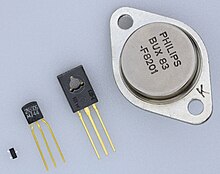
In electronics, TO-3 is a designation for a standardized metal semiconductor package used for power semiconductors, including transistors, silicon controlled rectifiers, and, integrated circuits. TO stands for "Transistor Outline" and relates to a series of technical drawings produced by JEDEC.[1]
The TO-3 case has a flat surface which can be attached to a heatsink, normally via a thermally conductive but electrically insulating washer. The design originated at Motorola around 1955 from a group headed by Dr. Virgil E. Bottom.[2] who was director of research of the Motorola Semiconductor Division. The first use of this design was for the germanium alloy-junction power transistor 2N176 – the first power transistor to be put into quantity production.[2][3] The lead spacing was originally intended to allow plugging the device into a then-common tube socket.[4]
- ^ Cite error: The named reference
TO-3_Specwas invoked but never defined (see the help page). - ^ a b Bottom, Virgil (November 1992). "XIII Phoenix 1953–1958". FROM POSSUM HOLLER TO SINGAPORE The Autobiography of VIRGIL E. BOTTOM. Self published. p. 177. Archived from the original (DOC) on 2016-03-15. Retrieved 2022-08-22.
- ^ Ward, Jack (2007). "Motorola 2N176". www.semiconductormuseum.com. Retrieved 2022-08-22.
- ^ Greenburg, Ralph (2008). "Transistor Museum Oral History". www.semiconductormuseum.com. Retrieved 2021-07-14.
